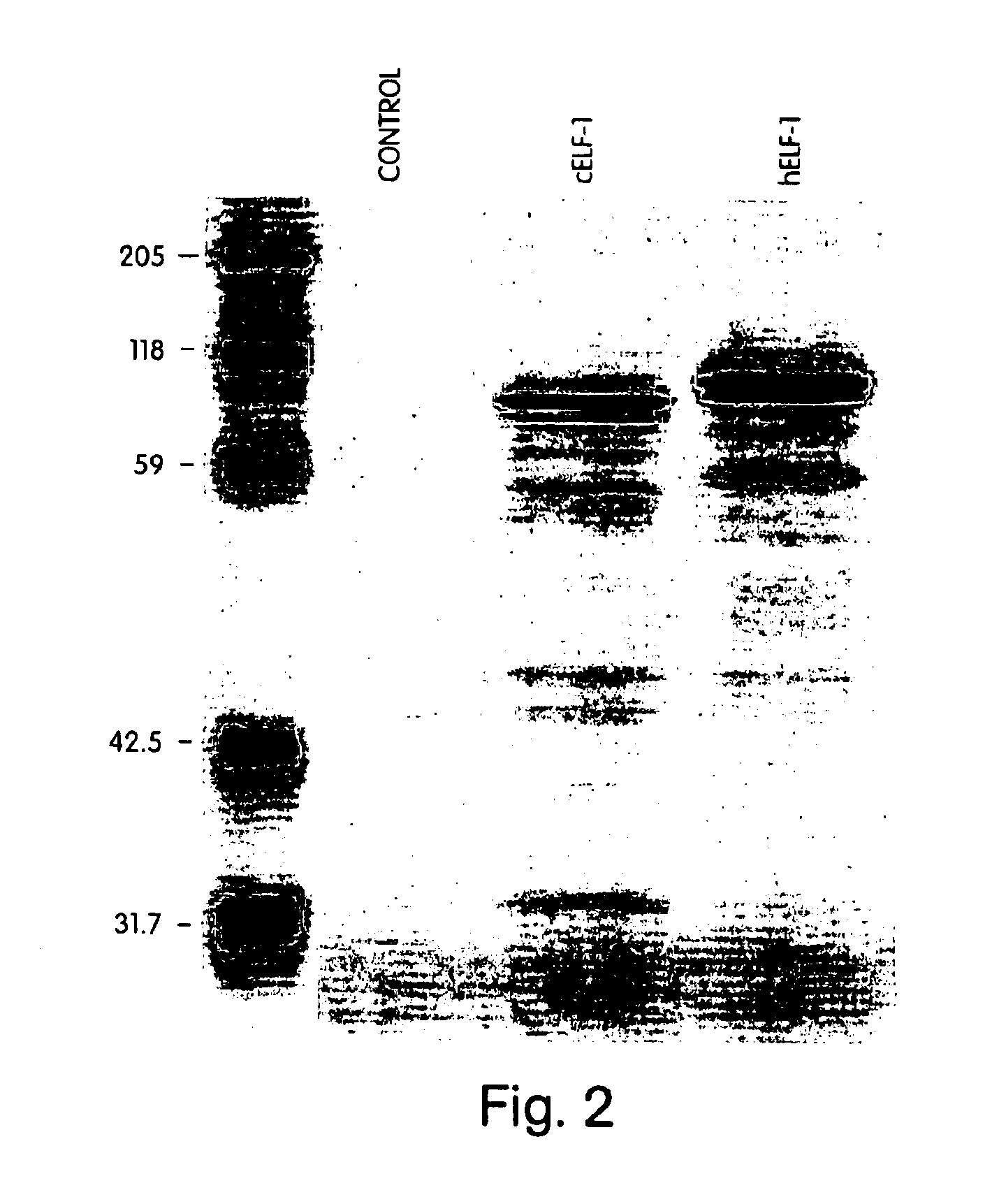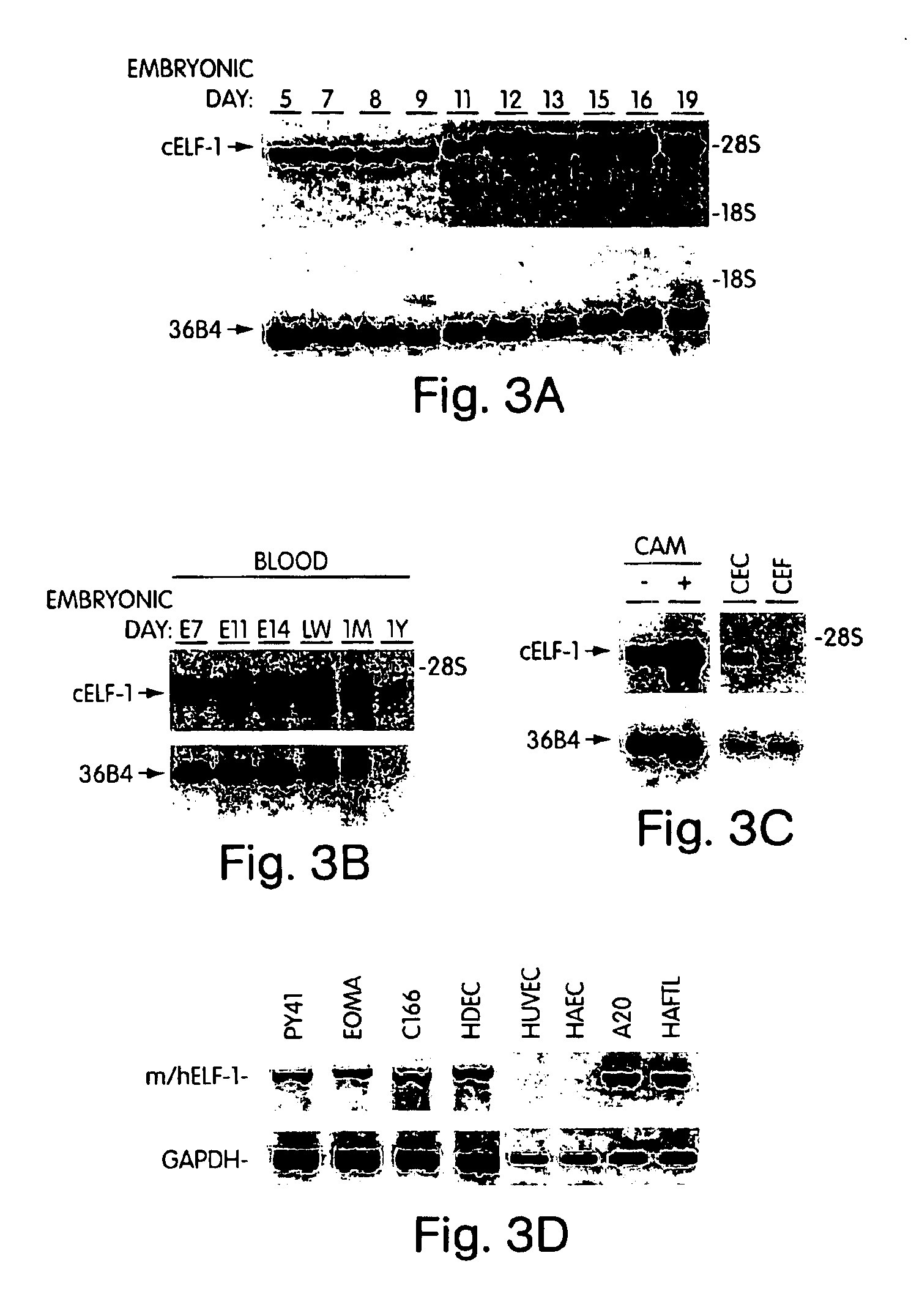Transcriptional mediators of blood vessel development and endothelial differentiation
a transcriptional mediator and endothelial technology, applied in the direction of depsipeptides, peptide/protein ingredients, fungi, etc., can solve the problems of incomplete ability to block angiogenesis in a variety of diseases, angiogenesis-dependent growth of many tumors, and diabetes retinopathy, etc., to achieve the effect of beneficial
- Summary
- Abstract
- Description
- Claims
- Application Information
AI Technical Summary
Benefits of technology
Problems solved by technology
Method used
Image
Examples
example 1
Isolation of the Chicken Homologue of ELF-1 (cELF-1)
[0138]In an effort to identify transcription factors belonging to the Ets family that are expressed during blood vessel development we chose to examine the highly vascular chicken chorioallantoic membrane. Vessels within the CAM undergo an exponential growth followed by a quiescent phase. Total RNA was extracted from blood vessels that were microdissected from 10 day old CAMs. RT-PCR was performed with degenerate PCR primers corresponding to conserved regions of the Ets domain allowing the identification of a partial DNA sequence for a member of the Ets factor family. This fragment was used to screen a chicken yolk sac cDNA library, and isolate a cDNA clone encoding the full length chicken homologue of ELF-1 (cELF-1). As is shown in FIG. 1, cELF-1 encodes a 617 amino acid long protein with an expected molecular weight of 71.0 kDa. The highest degree of homology to ELF-1 exists in the DNA binding domain (100%), with overall protein ...
example 2
Expression Pattern of cELF-1 in the Chicken CAM
[0139]To determine the expression pattern of cELF-1 in the CAM, northern blot analysis was performed using RNA derived from CAM blood vessels at different developmental stages. As is shown in FIG. 3A, cELF-1 is highly expressed in the CAM blood vessels. Because it has previously been shown that ELF-1 is expressed in T and B cells, we examined the expression of cELF-1 in fetal chicken blood at different stages of development. As expected, cELF-1 is also highly expressed in chicken blood(FIG. 3B). To ascertain whether cELF-1 is expressed in the CAM blood vessels devoid of blood, RNA was extracted from CAM blood vessels flushed free of blood and from unflushed CAMs. Although flushing the blood vessels diminishes the expression of cELF-1, there is still significant expression of cELF-1 in the flushed vessels(FIG. 3C). Furthermore, cELF-1 expression is demonstrated in fetal chicken endothelial cells, as compared to chicken fibroblasts, which...
example 3
ELF-1 is Expressed in a Subset of Human and Murine Endothelial Cells
[0140]Surprisingly, cELF-1 was highly expressed in the CAM blood vessels. We had previously examined ELF-1 expression in human endothelial cells and had not detected it in either human umbilical vein endothelial cells (HUVECs) or human aortic endothelial cells (HAECs) (Dube A, et al. Circ Res. 1999;84:1177-1185). To extend these studies we examined additional murine and human endothelial cells for the expression of ELF-1. As is shown in FIG. 3D, ELF-1 is also expressed in the murine yolk sac endothelial line C166, EOMA and PY41 endothelioma lines, and human dermal microvascular endothelial cells. This suggests that ELF-1 is only expressed in a subset of endothelial cells. As a positive control we used the B cell lines A20 and HAFTL that we have previously shown express ELF-1 (Oettgen P, et al. Mol Cell Biol. 1996;16:5091-5106).
PUM
| Property | Measurement | Unit |
|---|---|---|
| Fraction | aaaaa | aaaaa |
| Current | aaaaa | aaaaa |
| Digital information | aaaaa | aaaaa |
Abstract
Description
Claims
Application Information
 Login to View More
Login to View More - R&D
- Intellectual Property
- Life Sciences
- Materials
- Tech Scout
- Unparalleled Data Quality
- Higher Quality Content
- 60% Fewer Hallucinations
Browse by: Latest US Patents, China's latest patents, Technical Efficacy Thesaurus, Application Domain, Technology Topic, Popular Technical Reports.
© 2025 PatSnap. All rights reserved.Legal|Privacy policy|Modern Slavery Act Transparency Statement|Sitemap|About US| Contact US: help@patsnap.com



